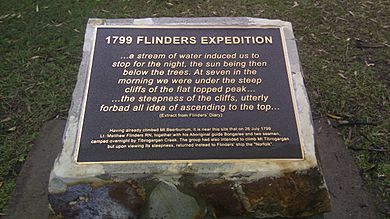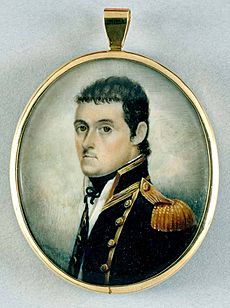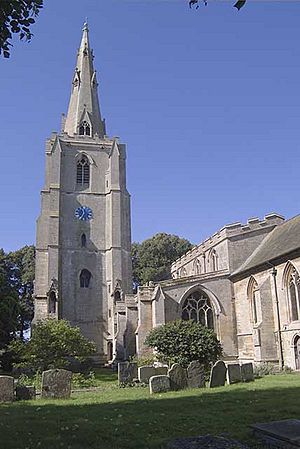Matthew Flinders facts for kids
Quick facts for kids
Matthew Flinders
|
|
|---|---|
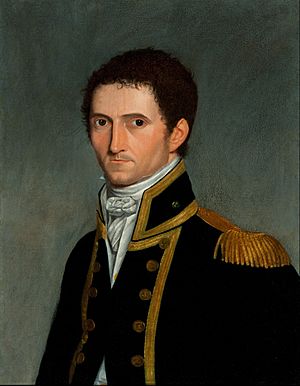
Portrait by Antoine Toussaint de Chazal, painted in Mauritius in 1806–07
|
|
| Born | 16 March 1774 Donington, Lincolnshire, England
|
| Died | 19 July 1814 (aged 40) London, England
|
| Resting place | St James's burial ground, Camden (until 2019) |
| Occupation | Royal Navy officer |
| Years active | 1791–1814 |
| Spouse(s) |
Ann Chappelle
(m. 1801) |
| Children | 1 |
Captain Matthew Flinders (16 March 1774 – 19 July 1814) was a British navigator and cartographer.
Flinders was involved in several voyages of discovery between 1791 and 1803, the most famous of which is the first inshore circumnavigation of mainland Australia. He is credited as being the first person to utilise the name Australia to describe the entirety of that continent including Van Diemen's Land (now Tasmania). Flinders did not live to see his name for the continent widely accepted.
Contents
Early life
Matthew Flinders was born in Donington, Lincolnshire, the son of Matthew Flinders, a surgeon, and his wife Susannah (née Ward). He was educated at Cowley's Charity School, Donington, from 1780 and then at the Reverend John Shinglar's Grammar School at Horbling in Lincolnshire.
In 1789, at the age of fifteen, Flinders joined the Royal Navy. Under the patronage of Captain Thomas Pasley, Flinders was initially assigned to HMS Alert as a servant, but was soon transferred as an able-seaman to HMS Scipio, and then in July 1790 was made midshipman on HMS Bellerophon.
Expeditions
Flinders took part in several expeditions between 1791 and 1803. In 1795, Flinders' desire for adventure led him to enlist as a midshipman aboard HMS Reliance going to New South Wales. On this voyage Flinders, became friends with the ship's surgeon George Bass, who from then on accompanied Flinders on many of his voyages of discovery. In 1795, Bass and Flinders organised an expedition in a small open boat named Tom Thumb in which they sailed to Botany Bay and up the Georges River. In March 1796, the two explorers set out on another voyage in a larger boat dubbed Tom Thumb II. They sailed south from Port Jackson but were soon forced to beach at Red Point (Port Kembla). During the return to Sydney they had to seek shelter at Wattamolla and also explored some of Port Hacking (Deeban).
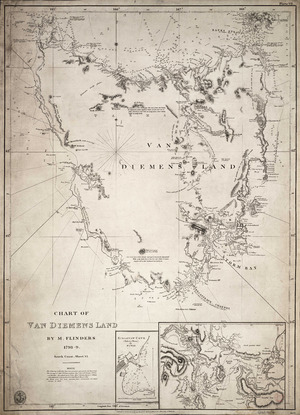
In 1798, Flinders, now a lieutenant, was given command of the sloop Norfolk. With Bass and several crewmen, he sailed the Norfolk along the uncharted northern and western coasts of Van Diemen's Land, rounded Cape Pillar and returned to Furneaux's Islands. By doing so, Flinders had completed the circumnavigation of Van Diemen's Land and confirmed the presence of a strait between it and the mainland. The passage was named Bass Strait after his close friend, and the largest island in the strait would later be named Flinders Island in his honour.
In 1799 Flinders' request to explore the coast north of Port Jackson was granted and once more the sloop Norfolk was assigned to him. Bass had by this stage returned to Britain and in his place Flinders recruited his brother Samuel Flinders and a Kuringgai man named Bungaree for the voyage. They departed on 8 July 1799.
In the northern part of Moreton Bay, Flinders explored a narrow waterway (27°04′14″S 153°08′34″E / 27.0705°S 153.1429°E) which he named the Pumice Stone River (presumably unaware it separated Bribie Island and the mainland); it is now called the Pumicestone Passage.
Exiting Moreton Bay, Flinders continued north exploring as far as Hervey Bay before returning south. They arrived back in Sydney on 20 August 1799.
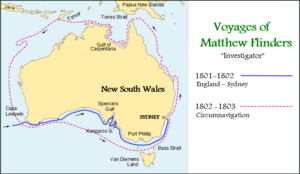
In January 1801, Flinders was promoted to commander and given command of HMS Investigator, a 334-ton sloop, sailing for New Holland on 18 July 1801 with the aim of charting Australian coastline.
Attached to the expedition were the botanist Robert Brown, botanical artist Ferdinand Bauer, landscape artist William Westall, gardener Peter Good, geological assistant John Allen, and John Crosley as astronomer.
Aboard Investigator, Flinders reached and named Cape Leeuwin on 6 December 1801, and proceeded to make a survey along the southern coast of the Australian mainland.
After spending 12 weeks in Sydney resupplying and enlisting further crew for the continuation of the expedition to the northern coast of Australia, Flinders headed north and surveyed the coast of what would later be called Queensland. The expedition continued north but navigation became increasingly difficult as they entered the Great Barrier Reef. Flinders exited the reefs near to the Whitsunday Islands and sailed Investigator north to the Torres Strait. On 29 October, they arrived at Murray Island in the east of this strait, where they traded iron for shell necklaces with the local people.
The expedition entered the Gulf of Carpentaria on 4 November and charted the coast to Arnhem Land. On 17 February 1803, near Cape Wilberforce, the expedition encountered a Makassan trepanging fleet captained by a man called Pobasso, from whom Flinders obtained information about the region.
During this part of the voyage, much of the Investigator was discovered to be rotten, and Flinders made the decision to complete the circumnavigation of the continent without any further close surveying of the coast. Arriving in Sydney on 9 June 1803, the Investigator was judged to be unseaworthy and condemned.
Attempted return to England and imprisonment
Flinders then took command of the 29-ton schooner HMS Cumberland in order to return to England, but the poor condition of the vessel forced him to put in at French-controlled Isle de France (now known as Mauritius) for repairs on 17 December 1803, just three months after Baudin had died there.
War with France had broken out again the previous May, but Flinders hoped his French passport (despite its being issued for Investigator and not Cumberland) and the scientific nature of his mission would allow him to continue on his way.
Despite this, the French governor, Charles Mathieu Isidore Decaen, detained Flinders. Decaen was suspicious of the alleged scientific mission as the Cumberland carried no scientists and Decaen's search of Flinders' vessel uncovered a trunk full of papers (including despatches from the New South Wales Governor Philip Gidley King) that were not permitted under his scientific passport.
Decaen referred the matter to the French government; this was delayed not only by the long voyage but also by the general confusion of war. Eventually, on 11 March 1806, Napoleon gave his approval, but Decaen still refused to allow Flinders' release. By this stage Decaen believed Flinders' knowledge of the island's defences would have encouraged Britain to attempt to capture it. Nevertheless, in June 1809 the Royal Navy began a blockade of the island, and in June 1810 Flinders was paroled. Travelling via the Cape of Good Hope on Olympia, which was taking despatches back to Britain, he received a promotion to post-captain, before continuing to England.
In November 1804 he sent the first map of the landmass he had charted (Y46/1) back to England. This was the only map made by Flinders where he used the name "Australia or Terra Australis" for the title instead of New Holland the name of the continent that James Cook had used in 1770. He used the name New Holland on his map only for the western part of the continent.
Flinders finally returned to England in October 1810. He was in poor health but immediately resumed work preparing A Voyage to Terra Australis and his atlas of maps for publication. Original copies of the Atlas to Flinders' Voyage to Terra Australis are held at the Mitchell Library in Sydney as a portfolio that accompanied the book and included engravings of 16 maps, four plates of views and ten plates of Australian flora. The book was republished in three volumes in 1964, accompanied by a reproduction of the portfolio. Flinders' map of Terra Australis or Australia (so the two parts of the double name of his 1804 manuscript reversed) was first published in January 1814 and the remaining maps were published before his atlas and book.
Death and reburial
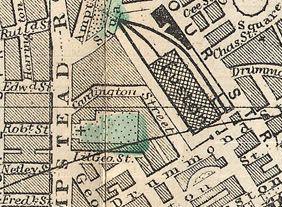
Flinders died, aged 40, on 19 July 1814 from kidney disease, at his London home at 14 London Street, later renamed Maple Street and now the site of the BT Tower. This was on the day after the book and atlas was published; Flinders never saw the completed work as he was unconscious by that time. On 23 July he was interred in the burial ground of St James's Church, Piccadilly, which was located some distance from the church, beside Hampstead Road, Camden, London. The burial ground was in use from 1790 until 1853. By 1852 the location of the grave had been forgotten due to alterations to the burial ground.
His grave was located in January 2019 by archaeologists. His coffin was identified by its well-preserved lead coffin plate. Film of the discovery and the exhumation was shown in a documentary on British television in September 2020. It was proposed to re-bury his remains.
On 17 October 2019 HS2 Ltd announced that Flinders remains could be reinterred in the church in Donington, where he was baptised. Permission has been given by the Diocese of Lincoln for reburial in the north aisle.
Family
On 17 April 1801, Flinders married his longstanding friend Ann Chappelle (1772–1852) and had hoped to take her with him to Port Jackson. However, the Admiralty had strict rules against wives accompanying captains. Flinders brought Ann on board ship and planned to ignore the rules, but the Admiralty learned of his plans and reprimanded him for his bad judgement, and ordered him to remove her from the ship.
As a result, Ann was obliged to stay in England and would not see her husband for nine years, following his imprisonment on the Isle de France (Mauritius, at the time a French possession) on his return journey. When they finally reunited, Matthew and Ann had one daughter, Anne, (1 April 1812 – 1892), who later married William Petrie (1821–1908). In 1853, the governments of New South Wales and Victoria bequeathed a belated pension to her (deceased) mother of £100 per year, to go to surviving issue of the union. This she accepted on behalf of her young son, William Matthew Flinders Petrie, who would go on to become an accomplished archaeologist and Egyptologist.

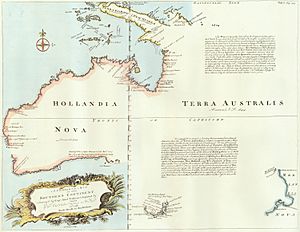
Legacy of Flinders
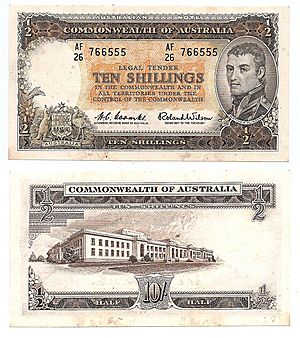
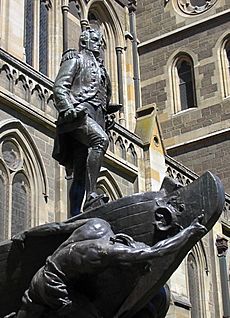
Flinders is considered the main explorer of South Australia. Landmarks named after him include the Flinders Ranges and Flinders Ranges National Park, Flinders Column at Mount Lofty, Flinders Chase National Park on Kangaroo Island, Flinders University, Flinders Medical Centre, the suburb Flinders Park and Flinders Street in Adelaide. In Victoria, eponymous places include Flinders Peak, Flinders Street in Melbourne, the suburb of Flinders, the federal electorate of Flinders, and the Matthew Flinders Girls Secondary College in Geelong.
Flinders Bay in Western Australia and Flinders Way in Canberra also commemorate him. Educational institutions named after him include Flinders Park Primary School in South Australia, and Matthew Flinders Anglican College on the Sunshine Coast in Queensland. A former electoral district of the Queensland Parliament was named Flinders. There are also Flinders Highways in both Queensland and South Australia.
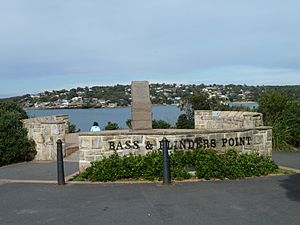
Bass & Flinders Point in the southernmost part of Cronulla in New South Wales features a monument to George Bass and Matthew Flinders, who explored the Port Hacking estuary.
Australia holds a large collection of statues erected in Flinders' honour. In July 2014, on the 200-year anniversary of his death, a large bronze statue of Flinders by the sculptor Mark Richards was unveiled at Australia House, London by Prince William, Duke of Cambridge, and later installed at Euston station near the presumed location of his grave.
In 1964 he was honoured on a postage stamp issued by Postmaster-General's Department, again in 1980, and in 1998 with George Bass.
Flindersia is a genus of fourteen species of tree in the citrus family; it was named by Investigator's botanist, Robert Brown in honour of Flinders. The eastern school whiting, Sillago flindersi is named after him.
Flinders landed on Coochiemudlo Island on 19 July 1799, while he was searching for a river in the southern part of Moreton Bay, Queensland, Australia. The island's residents celebrate Flinders Day annually, commemorating the landing. The celebrations are usually held on a weekend near 19 July, the actual date of the landing.
Flinder's explorations of the Hervey Bay area are commemorated by a monument called Matthew Flinders Lookout at the top of an escarpment facing the bay in Dayman Park, Urangan (25°17′21″S 152°54′29″E / 25.2893°S 152.9080°E).
Flinder's Memorial in Maconde, Mauritius - The Captain Flinders Memorial is a stone memorial located close to Macondé, Mauritius on the ocean's edge. The memorial is located close to where Captain Flinders landed on the 17th December 1803, whilst commanding HMS Cumberland. The memorial has a brass plaque with the title "Captain Matthew Flinders RN 1774 - 1814, Explorer, Navigator and Hydrographer. The details show Captain Flinders, sitting at his desk with a map showing the Indian Ocean and Australia.
Interesting facts about Matthew Flinders
- Flinder decided to become a navigator after reading Robinson Crusoe.
- His first direct association with the Australian continent took place in February 1792, when Flinders arrived at Adventure Bay in the south of what is now called Tasmania as part of William Bligh's expedition on HMS Providence transporting breadfruit from Tahiti to Jamaica.
- Flinders was not the first to use the word "Australia", nor was he the first to apply the name specifically to the continent. He owned a copy of Alexander Dalrymple's 1771 book An Historical Collection of Voyages and Discoveries in the South Pacific Ocean, and it seems likely he borrowed it from there, but he applied it specifically to the continent, not the whole South Pacific region.
- Flinders' name is now associated with over 100 geographical features and places in Australia, including Flinders Island in Bass Strait.
- In his native England, the first statue of Flinders was erected on 16 March 2006 (his birthday) in his hometown of Donington. The statue also depicts his beloved cat Trim, who accompanied him on his voyages.
- Flinders coined the term "dodge tide" in reference to his observations that the tides in the very shallow Spencer and St Vincent's Gulfs seemed to be completely inert for several days, at select locations. Such phenomena have now also been found in the Gulf of Mexico and in the Irish Sea.
- Flinders' proposal for the use of iron bars to be used to compensate for the magnetic deviations caused by iron on board a ship resulted in their being known as Flinders bars.
Works
- A Voyage to Terra Australis, with an accompanying Atlas. 2 vol. – London : G & W Nicol, 18 July 1814
- Australia Circumnavigated: The Journal of HMS Investigator, 1801–1803. Edited by Kenneth Morgan, 2 vols, The Hakluyt Society, London, 2015.[1]
- Trim: Being the True Story of a Brave Seafaring Cat.
- Private Journal 1803–1814. Edited with an introduction by Anthony J. Brown and Gillian Dooley. Friends of the State Library of South Australia, 2005.
- Flinders, Matthew (1806). "Observations upon the Marine Barometer, Made during the Examination of the Coasts of New Holland and New South Wales, in the Years 1801, 1802, and 1803". Philosophical Transactions of the Royal Society 96: 239–266. doi:10.1098/rstl.1806.0012. http://en.wikisource.org/w/index.php?title=Philosophical_Transactions/Volume_96/Number_10.
- Flinders, Matthew (1805). "Concerning the Differences in the Magnetic Needle, on Board the Investigator, Arising from an Alteration in the Direction of the Ship's Head". Philosophical Transactions of the Royal Society 95: 186–197. doi:10.1098/rstl.1805.0012.
See also
 In Spanish: Matthew Flinders para niños
In Spanish: Matthew Flinders para niños
- European and American voyages of scientific exploration
- Flinders bar
- List of explorers
- Matthew Flinders Medal and Lecture
- Matthew Flinders' Cat, a novel by Bryce Courtenay (2002)
- Trim (cat)


